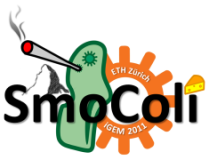Team:ETH Zurich/Modeling
From 2011.igem.org
| Line 1: | Line 1: | ||
{{:Team:ETH Zurich/Templates/Header/Modeling|currPage=Modeling}} | {{:Team:ETH Zurich/Templates/Header/Modeling|currPage=Modeling}} | ||
| + | {|class="roundContainer" | ||
| + | |style="font-size:2em; height: 30px" class="modeling"|Modeling Overview | ||
| + | | | ||
| + | {|class="linkMap modelingTitle" align="right" | ||
| + | |- | ||
| + | |style="border-left: none;"|[[#Why modeling?|Why modeling?]] | ||
| + | |[[#Results|Results]] | ||
| + | |} | ||
| + | |- | ||
| + | |colspan="2"|'''blablabla... Intoduction... check and write more''' | ||
| + | |} | ||
| - | + | {|class="roundContainer" | |
| - | + | | | |
We created a computational model of our system in order to check whether our ideas will work in reality. For example, before starting with the channel design, we had to first find out in silico what the most suitable channel dimensions are. Most of the model equations and parameters we took from existing literature, which is supported by biological data. For some of them, we had to make assumptions or small adjusments, so that they meet the biological conditions under which we create our system in the laboratories. | We created a computational model of our system in order to check whether our ideas will work in reality. For example, before starting with the channel design, we had to first find out in silico what the most suitable channel dimensions are. Most of the model equations and parameters we took from existing literature, which is supported by biological data. For some of them, we had to make assumptions or small adjusments, so that they meet the biological conditions under which we create our system in the laboratories. | ||
| Line 9: | Line 20: | ||
Then, we used the COMSOLE software to simulate diffusion of the toxic molecules to see whether a realistic gradient could be created. This is the point when we started to get some feeling about the channel dimensions. | Then, we used the COMSOLE software to simulate diffusion of the toxic molecules to see whether a realistic gradient could be created. This is the point when we started to get some feeling about the channel dimensions. | ||
| - | At the end, we combined the single cell model with the diffusion model to get the final (reaction-diffusion model) in | + | At the end, we combined the single cell model with the diffusion model to get the final (reaction-diffusion model) in COMSOL. By visualizing the diffusion and the movement of the GFP band, we saw that our system can actually work in practice. |
| + | |} | ||
Revision as of 14:06, 21 September 2011
| Modeling Overview |
| ||
| blablabla... Intoduction... check and write more | |||
|
We created a computational model of our system in order to check whether our ideas will work in reality. For example, before starting with the channel design, we had to first find out in silico what the most suitable channel dimensions are. Most of the model equations and parameters we took from existing literature, which is supported by biological data. For some of them, we had to make assumptions or small adjusments, so that they meet the biological conditions under which we create our system in the laboratories. First, we simulated the single cell model (Link here) in MATLAB to see whether every module (sensor, band detector, filter) works properly. Most of the parameter manipulations and fine tuning of the system were done on the single sell model. Then, we used the COMSOLE software to simulate diffusion of the toxic molecules to see whether a realistic gradient could be created. This is the point when we started to get some feeling about the channel dimensions. At the end, we combined the single cell model with the diffusion model to get the final (reaction-diffusion model) in COMSOL. By visualizing the diffusion and the movement of the GFP band, we saw that our system can actually work in practice. |
 "
"

